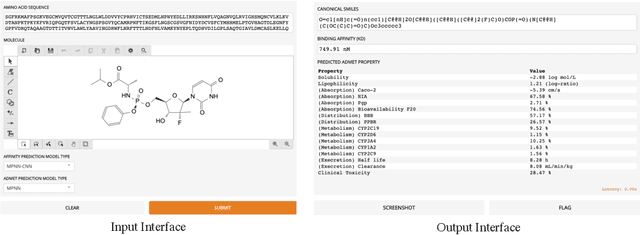Dawood Khan
MolDesigner: Interactive Design of Efficacious Drugs with Deep Learning
Oct 05, 2020
Abstract:The efficacy of a drug depends on its binding affinity to the therapeutic target and pharmacokinetics. Deep learning (DL) has demonstrated remarkable progress in predicting drug efficacy. We develop MolDesigner, a human-in-the-loop web user-interface (UI), to assist drug developers leverage DL predictions to design more effective drugs. A developer can draw a drug molecule in the interface. In the backend, more than 17 state-of-the-art DL models generate predictions on important indices that are crucial for a drug's efficacy. Based on these predictions, drug developers can edit the drug molecule and reiterate until satisfaction. MolDesigner can make predictions in real-time with a latency of less than a second.
Gradio: Hassle-Free Sharing and Testing of ML Models in the Wild
Jun 06, 2019


Abstract:Accessibility is a major challenge of machine learning (ML). Typical ML models are built by specialists and require specialized hardware/software as well as ML experience to validate. This makes it challenging for non-technical collaborators and endpoint users (e.g. physicians) to easily provide feedback on model development and to gain trust in ML. The accessibility challenge also makes collaboration more difficult and limits the ML researcher's exposure to realistic data and scenarios that occur in the wild. To improve accessibility and facilitate collaboration, we developed an open-source Python package, Gradio, which allows researchers to rapidly generate a visual interface for their ML models. Gradio makes accessing any ML model as easy as sharing a URL. Our development of Gradio is informed by interviews with a number of machine learning researchers who participate in interdisciplinary collaborations. Their feedback identified that Gradio should support a variety of interfaces and frameworks, allow for easy sharing of the interface, allow for input manipulation and interactive inference by the domain expert, as well as allow embedding the interface in iPython notebooks. We developed these features and carried out a case study to understand Gradio's usefulness and usability in the setting of a machine learning collaboration between a researcher and a cardiologist.
 Add to Chrome
Add to Chrome Add to Firefox
Add to Firefox Add to Edge
Add to Edge